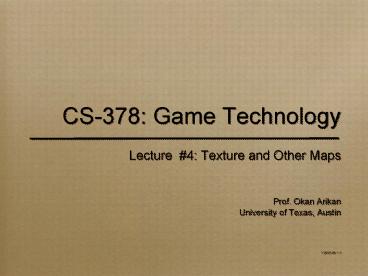CS378: Game Technology - PowerPoint PPT Presentation
1 / 23
Title:
CS378: Game Technology
Description:
We can't explicitly model all the rich detail. So, we come up with some 'hacks' ... The idea is to wrap a 'texture' onto a surface. To do this we need ... – PowerPoint PPT presentation
Number of Views:61
Avg rating:3.0/5.0
Title: CS378: Game Technology
1
CS-378 Game Technology
- Lecture 4 Texture and Other Maps
- Prof. Okan Arikan
- University of Texas, Austin
- V2005-09-1.1
2
Today
- Maps
- Texture Mapping
- Bump Mapping
- Displacement Mapping
- Shadow Maps
- Environment Maps
- Compositing
3
Surface Detail
- The real world is complicated
- We cant explicitly model all the rich detail
- So, we come up with some hacks...
4
Texture Mapping
- The idea is to wrap a texture onto a surface
- To do this we need
- A texture, usually just an image
- A parameterization of the surface
- A mapping from the surface parameterization to
the texture coordinates
5
Barycentric Coordinates
- can be expressed as
- where
- or, alternatively as
6
Barycentric Coordinates
- We can use barycentric coordinates to interpolate
any quantity (color, texture coordinates, etc)
stored at vertices, not just positions.
7
Bad Idea
- Simplest (and fastest) approach is to compute
texture coordinates for polygon vertices and
interpolate in screen space. - This gives the image on the right.
8
Undoing Homogenization
- Let be the point of
some polygon, after projection, but before
homogenization - The homogenized point is the
location of on the screen. - Let be a point we wish to shade, we have its
barycentric coordinates in screen space
9
Undoing Homogenization
- We know
- We also know that there exist weights , such
that - Combining the above we have
10
Undoing Homogenization
- This is a linear system in
- Unfortunately is is non-invertible, so...
11
Undoing Homogenization
- we add
- now its solvable and the solution is
- similar formulas exist for and
12
Bump/Displacement Mapping
- Texture mapping changes a surfaces reflectance,
but that cant give us a realistic orange - For this we can use bump or displacement mapping
13
Bump Mapping
- The idea is to perturb the surface normals
- If the bump map is an array of vectors, just add
the bump vectors to the surface normals - If the bump map is an array of scalars (desired
displacements along the normal direction), then
the new normal is
14
Displacement Mapping
- Actually perturb the location of the surface,
usually along the normal direction, by scalar
values given in the displacement map - This is usually done by moving the vertices of a
polygonal mesh
15
Bumps vs. Displacements
- Bumps do not cast shadows or change the
silhouette, they do produce specular effects - Displacements actually change the geometry
- Displacement maps only look good on high
resolution models - Bottom line bumps are cheaper, displacements
look better
16
Shadow Maps
- Key insight If we render the scene from the
point of view of the light source, the lit
surfaces will be visible and the unlit surfaces
will by hidden - We render the scene from the point of view of the
light source - Store the z values in a depth shadow map
17
Shadow Maps
- For each polygon
- Render the polygon from the camera
- Render the polygon from the light
- Compare the z value from the light with the one
in the depth shadow map - If they match, the polygon is lit
- Otherwise it is in shadow
18
Environment Maps
- Fake reflections
- Assumes the environment is very far away
- Depends on the location of the camera
- Usually stored in a spherical table or a cube map
19
Environment Maps
- Remove the reflective object from the scene
- Render the scene six times with the eye at the
center of the removed object - Render the scene, using reflection vectors to
index the cube map
20
Compositing
- Sometimes scenes are too complex to render all at
once - Different parts of a scene often do not interact
- Need a way to render pieces separately and put
them back together later
21
Alpha Channels
- Alpha channel stores opacity
- Primary operation is over
- Pre-multiplied alpha allows the use of the same
rules for all 4 channels
Normal Alpha Channel
Pre-multiplied Alpha Channel
22
Alpha Channel
- Other Operations
23
Suggested Reading
- Fundamentals of Computer Graphics by Pete Shirley
- Chapters 10, 3.4































